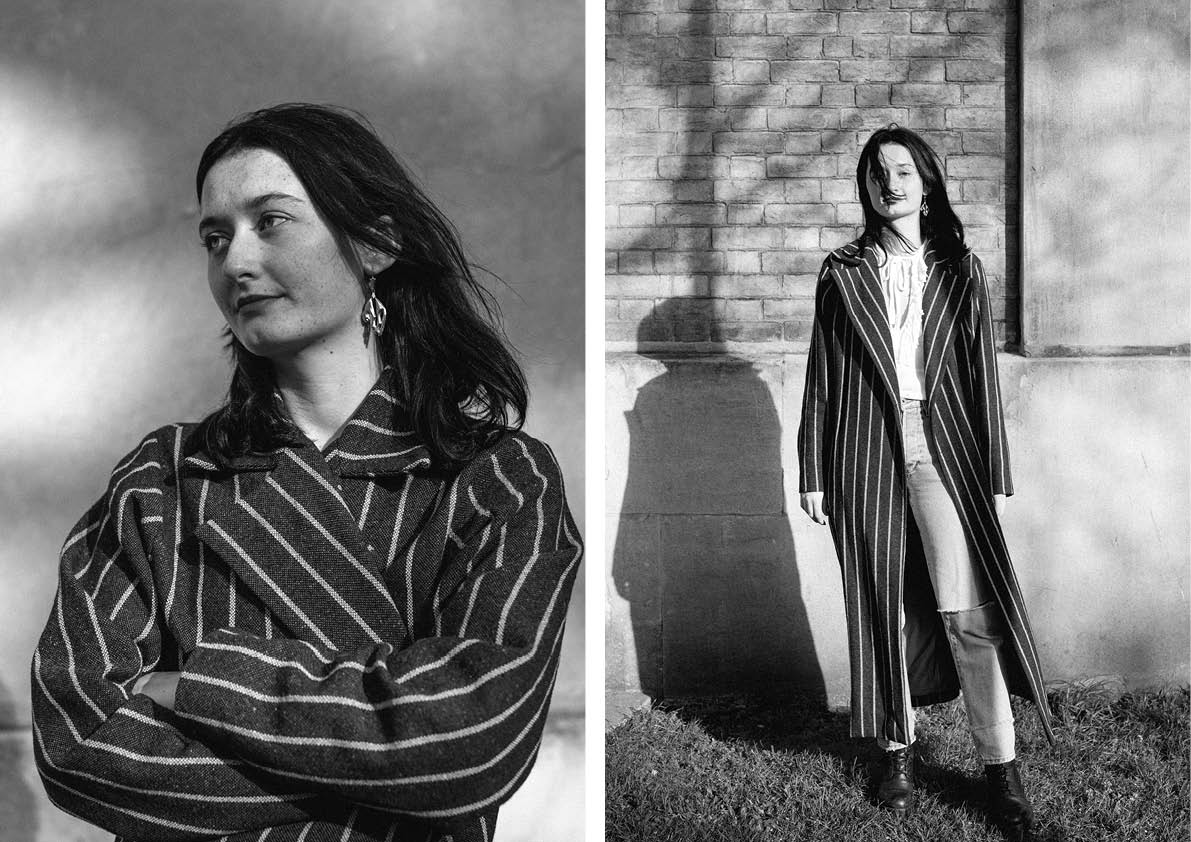
TOAST Portraits is a new series in which journalist Mina Holland and photographer Elena Heatherwick meet the people whose treasured TOAST pieces - some archive, some new - have stood the test of time. First up graphic design student Katy Brett ...
I meet Katy Brett to talk ostensibly about a coat but our conversation goes much deeper, into loss, anger and inheritance in its various forms. We meet outside St Mark's church in Kennington, close to where she lives in Oval. It forms a fitting backdrop, both for talk and taking photos: the vertical stripes of her coat echoing the thick indents in the Greek column beside her.
The coat became Katy's when her mother died in 2014. It is a dark grey wool, striped with white, its azure silk lining occasionally making itself known, as though high-fiving the blue sky. Her mum, artist Sophie Macpherson, threw it over everything, but never in a put-together way, and Katy remembers how it garnered compliments at the school gates. She didn't understand why she liked such neutral colours then now she thinks she was ahead of her time.

Later, at her flat, just around the corner from St Mark's, Katy shows me some of her mum's work moored boats, mainly, tipped to one side, some nestled in south coast mud at low tide, others that suggest Venice. The colour palette is a theme consistent with Sophie's taste in clothes, hues that are washed out or muddied. She liked things that were decaying, rusting, Katy says, the skeletons of boats, Battersea power station, the insides of churches My parents moved from London to Chichester when she was pregnant with me, and there boats became more of a focus.

Katy is studying graphic design at St Martin's and is interested in the design of spaces for the public. She does much the same with the coat as Sophie did before her, throwing it over whatever she might be wearing. Today it is a pair of high-waisted light jeans from Joseph (also her mother's), a thin white shirt with a whiff of Victoriana, and some black platform boots she found at an exchange shop in Copenhagen. Outside the church, as a strand of black hair falls over her freckled face and a fat crow swoops into a branch above, I am unsurprised when Katy mentions her teenage Goth phase which, she says, sometimes still informs how she dresses. (I've long held that Wednesday Adams is a timeless style icon).
The coat which Sophie would have bought from TOAST in AW12 is just one of many of her mum's clothes that Katy has inherited. Three-quarters of those hanging in her room are Sophie's, from Austrian military jackets to a knitted coat from Oska, not to mention oversized shirts, wool cardigans and Indian mules with toes like embellished turrets.

After she died, I found myself wearing something of hers every day, though not consciously Katy is anxious not to sentimentalise this fact a reflex to sheath herself in her mum's things in her absence but says simply, of the coat, I feel myself in it. Maybe, because it was my mum's, it shows a part of me that people don't get to see. Sophie's clothes are an expression of Sophie, and now of Katy and of Sophie in Katy. I look at Sophie's paintings on the living room wall, at her battered novels on the shelves, at the woven rugs in the hallway, and think about my own equivalents. Things we inherit can be about more than remembering a person they become a part of us, plaiting themselves into our lives like genes.

Katy tells me that her degree puts emphasis on being able to communicate something, whatever the medium, and I quickly see that perspective on things is seasoned. We talk about Jean-Michel Basquiat, his beginnings in graffiti and what defacement can lend to a public space leading us on to the merits of vandalism. For her last project, she made a temple out of paper and asked her classmates to destroy it, publicly. She tells me how angry her mother was, and how while most people see anger as negative, Sophie never did, and nor now does she. It was just her and I guess I've taken that on I feel anger is important and that there are bigger things in life than being precious about buildings. Vandalism conveys of all that and can bring about things of value. Like Basquiat, I think, once a street artist whose canvases now posthumously gross higher at auction than those of any other American artist.

I can relate this to the rips in Katy's coat lining, all the more beautiful, somehow, for the history they hold. Oval, too, the at-once grand and grubby corner of London where Katy and her brother live, has for now been mostly spared from the lusty hands of capitalism. St Mark's, with its Grecian faade and cupola, is surrounded variously by smart Georgian terraces and a playground with a butchered fence, a Payless supermarket, the Palace Grill and a coffee shop on the corner which serves cortados from vintage tea cups. I feel Oval somehow embodies me and my brother, says Katy, it's in between places, and perhaps doesn't know quite what it is. I wonder if she does know, though, that St Mark's sits on a Roman road once called Stane Street, built to link London with her mum's town of Chichester.
Words by Mina Holland. Photography by Elena Heatherwick.
Add a comment